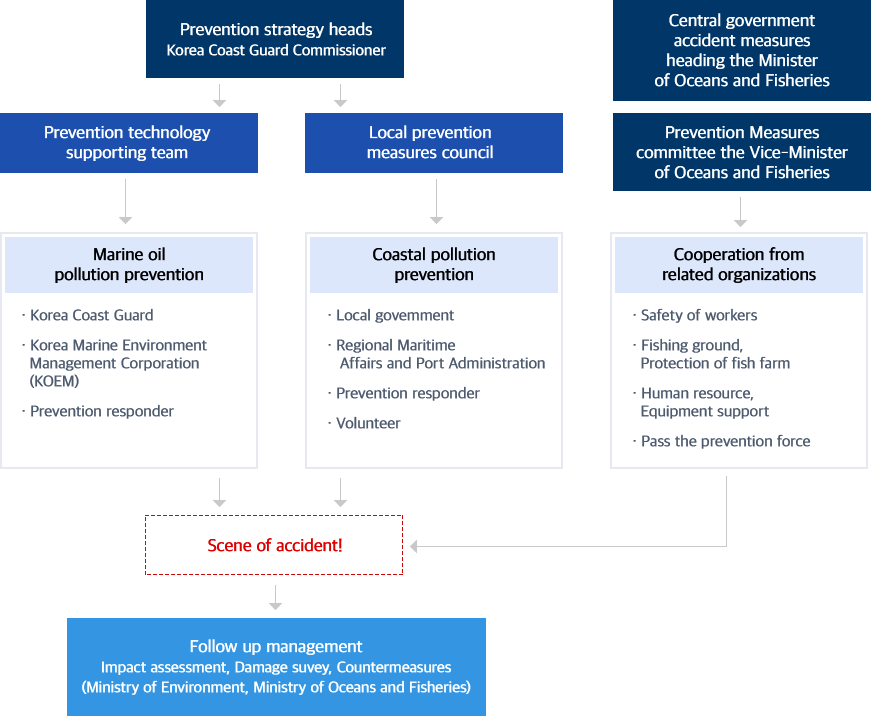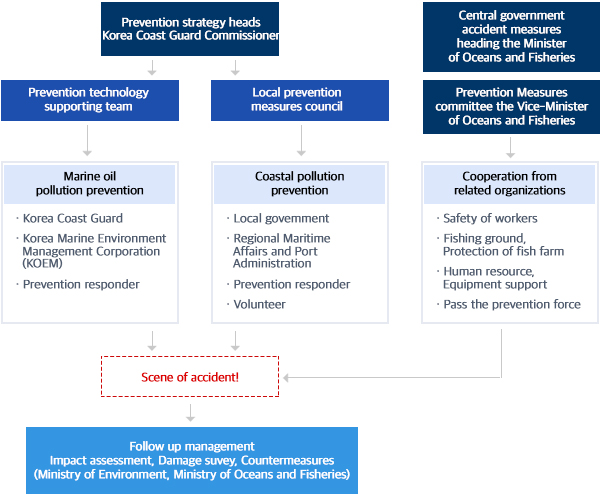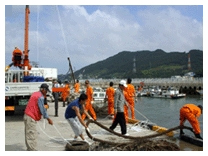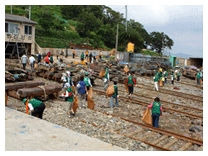Marine Environment
Marine Pollution Prevention System
- An oil pollution prevention system should be established to respond to oil leaks from a ship in during construction work. Materials and chemicals should be prepared in ships for construction within a port facility to prevent oil leaks.
- Since the Sea Prince Oil Spill Incident in 1995, Korea’s line of command for the marine pollution prevention has been consolidated into the Korea Coast Guard.
- The leadership of the Korea Coast Guard draws up concrete prevention measures and command systems, including emergency plans for the central government, local government, facility, port and oil tanker. It also manages organization, facilities, equipments and personnel education so as to enable it to respond swiftly and proactively to any marine accidents.
- The following should be observed in order to strengthen the capacity to prevent marine pollution, unexpected accidents in construction areas and to enhance the safe navigation systems of a vessels: extend the controlling and management capacity of national prevention systems; enhance prevention equipment and skilled human resources; secure funds for urgent prevention; and, make it a rule to install prevention equipments in the oil storage within a construction zone.
Pollution Response System


Available Prevention Material
| Item | Oil fense(m) | Oil dispersent(ℓ) | Oil adsorbent(㎏) | |
|---|---|---|---|---|
| Storage | ||||
| Total | 1,660 | 9,944 | 1,380 | |
| Yeosu Regional Maritime Affairs and Port Administration | Yeosu Port warehouse | - | - | - |
| Yeocheon Maritime Office | Nak-po Port warehouse | - | 2,800 | 400 |
| Gwangyang Maritime Office | Management Port warehouse | 1,660 | 7,144 | 980 |
Korea Marine Environment Management Corporation
Related LawArticle 10 of Marine Environment Management Act, Korea Marine Environment Management Corporation
Purpose of EstablishmentThe Corporation aims to promote businesses to preserve, manage and improve marine the environment. It also boosts businesses for marine pollution prevention as well as the development of marine pollution-related technologies and education.
Purpose of Establishment- Marine environment preservation and management- related businesses
-
The following businesses could improve marine environment:
- Waste collection and treatment business
- Establishment and operation of waste storage, and consignment management
- Salvage and towing of vessels to prevent waste discharge
- Administration on marine environment related test, survey, research, design, development and construction
-
The following businesses could prevent marine pollution:
- Specific marine pollution prevention work and arrangement and establishment of water surface cleaners(consignment and agency work included)
- Securing materials and chemicals required for marine pollution prevention. Establishment of storage facilities(consignment and agency work included)
- Other marine pollution prevention businesses designated by an executive order
- Businesses fixed by the articles of association among businesses out of 1 and 3 above
- International cooperation on Marine Environment and Technical service
- Education, training and promotion on marine environment
- Businesses consigned by central or local governments in relation to 1 and 6 businesses above
- Other businesses required to attain the goals and designated by an executive order Korea Marine Environment Management Corporation(http://www.koem.or.kr)
Floating waste s on the water within a port
- Continue the “Campaign to clean nearby Coast” and “each related company cleans one coast area” campaign by joint efforts between a competent organization and an agency.
- Monitor marine waste dumping and collection of waste by activating Marine Environment Management Center
- Clean the marine environment by collecting floating waste using a water surface cleaner owned by KOEM
- Designate and practice “Sea Cleaning Day” (the 3rd Friday every Month)
- International Coastal Cleanup Day (the 3rd Saturday in Sep.)
"Campaign to clean up nearby shore line’s"
PurposeIn order for the successful hosting of “Expo 2012 Yeosu Korea”, the competent organizations, private companies and residents who used the surrounding areas of Yeosu New Port and waterfront voluntarily participated in the “Campaign to clean up nearby shorelines” to realize the motto “Living Ocean and Breathing Coast”
Campaign Direction- Voluntarily participating of the competent organizations, private companies, civic groups and residents in the “Campaign to clean up nearby coast”
- Flexibly select the shore area they will clean and the day they will participate in the campaign considering their location and home base.
- Continuous cleanup campaign and promotions for the sustainable marine environment
- Location: Yeosu New Port – Yeosu old Port (Jonghwa-dong) - Marine Park – Passenger Terminal
- Cleaning frequency: At least once a month
- Participants: The competent organizations, private companies, residents, civic groups (170 people from 37 organizations)
-
Activities
- Voluntary cleaning work in the responsible space
- Cleaning dumped and piled up waste
- Developing activities that best suit each organization and company so as to preserve maritime environment
Collection and treatment performance of marine wastes
| Classification | 2007 | 2008 | 2009 | 2010 | 2011 | |
|---|---|---|---|---|---|---|
| Participation | Organization | 84 | 138 | 280 | 228 | 165 |
| Number of participants | 2,408 | 3,260 | 2,777 | 1,891 | 1,974 | |
| Throughput (ton) | 500.5 | 470.9 | 347.3 | 515.6 | 465 | |
| Over the previous year(%) | 126.8 | 94.1 | 73.7 | 148.5 | 90.2 | |


Definition of ships left neglected
- A mooring ship that does not sail more than a year since the expiration day of its valid mooring period after being reported to a responsible organization for suspension of sailing or mooring
- A mooring ship which was already compensated for businesses related to reclamation of public water surface
- A ship that has not have its hull broken up even after the expiration of its registration lifetime
- A capsized or sunken ship that may hamper the public water surface environment and effective use, along with the risk to cause pollution in the space according to the judgment of a responsible government body.
Related Law
“Law on Management and Reclamation of Public Water Surface”, Article 6 (Removal of ships left idle)
Disposal Process of Ships Left Idle
Owner-confirmed ship
Notify a ship owner a removal order (over 14 days) → send a reminder (7 days) → Report to a related organization →A responsible government body notifies the ship owner and disposes the ship(by proxy)
※Removal cost: The ship owner pays, or covers the cost out of gains from public disposal of the idle ship.
Notify removal of the ship (over 14 days) → Remove the ship
A ship left idle with a security right- Solicit opinions from stakeholders (security right holders including the National Federation of Fisheries Cooperatives) about the ship left idle
- Conduct a joint survey with stakeholders, Coast guard and Korea Ship Safety Technology Authority
- Cancel the security right and dispose the ship according to the disposal procedure of owner-confirmed ship


